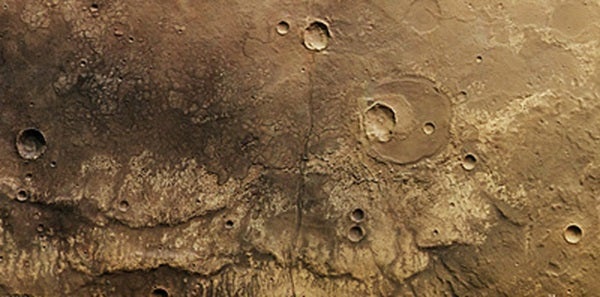The Mars Express High Resolution Stereo Camera imaged a region close to Ma’adim Vallis, one of the largest canyons on Mars, finding craters, lava flows, and tectonic features.
After Valles Marineris, Ma’adim Vallis is one of the largest canyons on Mars. The region, lying southeast of Ma’adim Vallis, was imaged December 24, 2008. The pictures are centered at about 29°S and 182°E and have a ground resolution of 49 feet (15 m) per pixel.
Ma’adim Vallis is located between the volcanic region of Tharsis, which harbors four volcanoes, including the largest in the solar system, and the Hellas Planitia impact basin. The canyon, 12 miles (20 kilometers) wide and 1 mile (1.6 kilometers) deep, originates in the southern highlands close to the ‘dichotomy boundary’ and ends in Gusev crater. The dichotomy boundary is a narrow region separating the cratered highlands, located mostly in the southern hemisphere of Mars, from the northern hemisphere’s lowland plains.
The image covers 86 by 43 miles (138 by 70 kilometers), roughly the size of Cyprus. A sharp boundary is visible in the center, dividing dark material to the west and light material to the east. Scientists suspect that this feature is most likely the edge of a basaltic lava flow.
Wrinkle ridges are clearly visible on the surface of the lava flow. They were most likely formed by compressive forces.
To the north is a crater, almost 12 miles (20 kilometers) in size. It is partially filled with lava, which shows that it must have formed before the lava set in. The smaller, 4 mile (7 kilometer) crater at the southern edge of the larger crater must have formed later because it has an ejecta blanket that may have formed from material rich in water-ice ejected during impact.
A linear feature, more than 124 miles (200 kilometers) long, divides the image almost in the center. It is most likely a trough associated with the uprising of the Tharsis volcanic region in the northeast. The uprising may have created a lot of stress in the crust that was released when the fracture zones formed, creating the trough.










